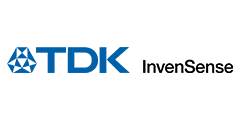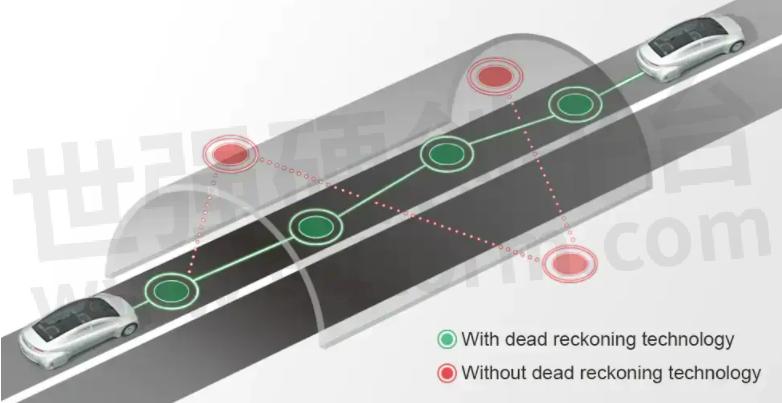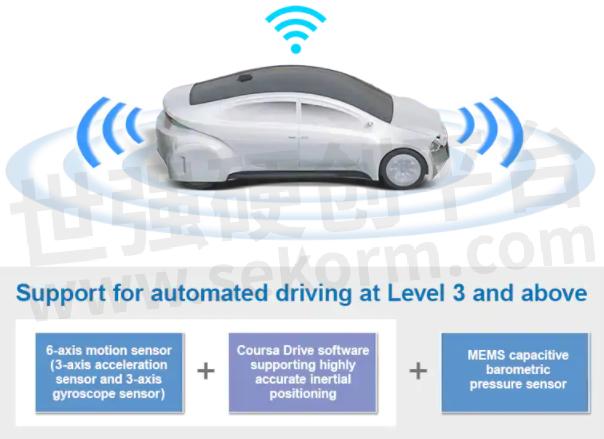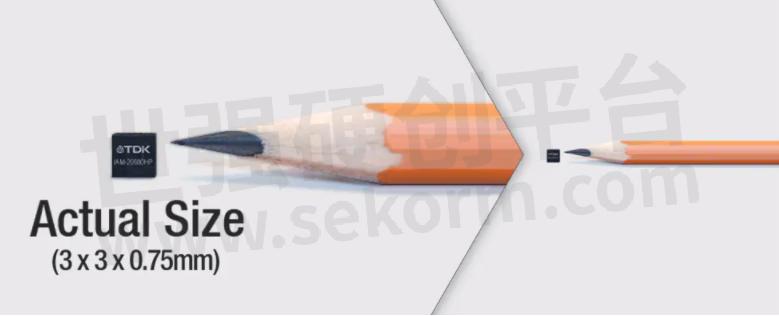TDK Sensor Fusions Support the Realization of Automated Driving Beyond Level 2

The development of automated driving systems is advancing at a rapid rate with the aim of creating a society offering new concepts in mobility. However, achieving high levels of automated driving technology beyond Level 2 will require various technologies in order to accomplish dead reckoning and 3D positioning. TDK is a manufacturer capable of supplying a diverse range of sophisticated sensor fusions to fulfill functions that would be impossible to achieve by combining stand-alone sensors, and continually leading the development of advanced technologies. Using its strengths in this field, TDK supports the realization of automated driving technologies beyond Level 2 by supplying motion sensors and newly developed Coursa Drive software under the InvenSense brand, as well as barometric pressure sensors.
Dead Reckoning and 3D Positioning Present Challenges in Moving Beyond Level 2 of Automated Driving
The six-level classification (levels 0 to 5) of automated driving determined by the US-based Society of Automotive Engineers (SAE)1 has been adopted worldwide. Large numbers of mid-range vehicles are expected to be equipped with Level 2 systems from 2020 onwards, and the fitting of Level 3 and 4 systems to commercial and high-end vehicles is predicted to begin in or after 2025.
Levels 3 and above can be called true automated driving, in the sense of autonomous vehicle operation. This is because vehicles at these levels are equipped with an automated driving mode that can drive without human control. In plain terms, this mode enables humans to leave driving up to the vehicle and perform simple tasks such as checking emails.
Levels of Automated Driving

However, there are various challenges in making the jump from Levels 1 and 2 to Levels 3 and above, one of which is dead reckoning.2 Even in environments beyond the range of Global Navigation Satellite Systems (GNSS) such as the Global Positioning System (GPS), dead reckoning software processes data from a range of sensors to calculate vehicle position and movement, enabling autonomous navigation to the destination while maintaining highly accurate positioning. Further advances in sensor and software technology are required to raise functionality from the level of existing navigation systems to automated driving levels.
Another challenge in stepping up to automated driving is the need to supplement the 2D maps of conventional navigation systems with 3D digital maps that display positioning information showing differences in elevation, such as data on surface-level roads underneath elevated expressways, multi-level interchanges, and parking structures. Development and creation of three-dimensional digital maps known as 3D dynamic maps,3 which display not only 3D positioning data but also dynamically changing factors such as traffic signals, pedestrians, and nearby vehicles, is already underway in many parts of the world. With the launch of 5G telecommunications services, such technologies are predicted to take shape in the near future.
Sophisticated Sensor Fusion Solutions Powered by Motion Sensors, Advanced Software, and Barometric Pressure Sensors
Motion sensors consisting of acceleration and gyroscope sensors are particularly crucial among the onboard sensors required for dead reckoning. Vehicle direction and orientation change from moment to moment due to factors such as bends, slopes, and lane changes; these changes in direction and orientation are detected by acceleration and gyroscope sensors. TDK’s IAM-20680HP is an in-car 6-axis Motion Sensor that harnesses MEMS fabrication to package a 3-axis acceleration sensor with a 3-axis gyroscope sensor. Capable of functioning at temperatures from -40 to +105℃, its quality is underpinned by the vast number of units sold, and it is highly rated worldwide.
Newly-developed Coursa Drive software supports highly accurate inertial positioning for autonomous vehicles. While measuring and maintaining vehicle position with a high degree of accuracy, it aids autonomous driving even beyond the range of GNSS signals and in environments where they are disrupted, such as tunnels, underground parking lots, and “urban canyons” between buildings. Through sensor fusions combining motion sensors with Coursa Drive, TDK is making remarkable advances in dead reckoning technology.
TDK also offers a line-up of MEMS capacitive barometric pressure sensors featuring ultra-low noise and superior temperature stability. These sensors enable highly accurate 3D positioning by adding data obtained from 3D dynamic maps to data on differences in elevation detected by barometric pressure sensors. TDK sensor solutions advance automated driving technologies beyond Level 2 by facilitating dead reckoning and 3D positioning. We supply a diverse range of advanced sensor fusions that would be impossible to achieve by combining stand-alone sensors.
Dead Reckoning Technology Powered by Motion Sensors and Coursa Drive

When a vehicle enters a tunnel, GPS/GNSS signals are disrupted and vehicle position cannot be confirmed. However, positioning systems that use dead reckoning technology powered by motion sensors combined with Coursa Drive enable highly accurate positioning even in tunnels.
TDK Sensor Fusions Support Automated Driving

IAM-20680HP 6-axis Motion Sensor

TDK’s IAM-20680HP 6-axis sensor is a high-performance version of the IAM-20680 that integrates a 3-axis gyroscope sensor and a 3-axis acceleration sensor into an LGA4 package measuring just 3 x 3 x 0.75 mm.
- +1 Like
- Add to Favorites
Recommend
- TDK Announces Worldwide Availability of High Performance Imu Platform to Enhance Automotive Application Accuracy
- TDK New 3-Axis Accelerometer IAM-20381HT, Finalizing Transition of SmartAutomotive™ Non-Safety Product Family to 105℃
- TDK Presents Second-Generation 6-axis IMUs for Advanced Driver Assistance and Safety Applications
- TDK Announces the InvenSense ICP-10125 Waterproof SmartPressure™ Sensor Platform, Achieving the Industry’s Lowest Pressure Noise of 0.4 Pa RMS
- TDK Launches InvenSense Sensor Partner Program to Empower IoT innovation with Sensor Technology
- InvenSense® Provides High-Accuracy Turn-By-Turn Navigation User Experience To HiSilicon Mobile Platforms and Huawei Smartphones
- TDK’s New SmartMotion® Platform Accelerates Development of IOT Solutions Based on Invensense Motion Sensors
- InvenSense® Announces UltraPrint™ Mass-Manufacturable Ultrasound Fingerprint Touch Sensor Solution
This document is provided by Sekorm Platform for VIP exclusive service. The copyright is owned by Sekorm. Without authorization, any medias, websites or individual are not allowed to reprint. When authorizing the reprint, the link of www.sekorm.com must be indicated.





























































































































































































































































































































































































































































































































































































































































































































































































































































































